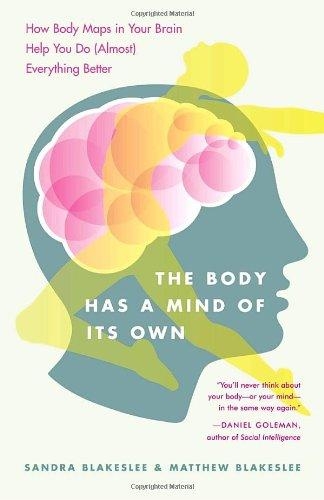Well, readers, it’s past time for a book review. I’m combining some topics. I hope you don’t mind (play on words intended), because the book I’m talking about today is one that touches on the deep connection between our bodies and our minds. This isn’t just experiential stuff, though, like I often talk about: this is science, and it’s fascinating.
“Viewing pain as a loss of homeostasis may solve one of the great medical mysteries of our age.” Sandra and Matthew Blakeslee
The book is The Body Has a Mind of Its Own: How Body Maps in Your Brain Help You do (Almost) Everything Better, by a mother and son science writing team: Sandra and Matthew Blakeslee. First of all, I have to confess that this book wasn’t at all what I had expected. I thought it would talk about the complex of nerves in the abdomen, which has been dubbed the second brain by some, or about the signaling molecules that go back and forth between the body and the brain, as in Candace Pierce’s work. It doesn’t.
Instead, it mainly considers research detailing a wide number of mappings from the body to the brain (and somewhat vice versa). In a basic physiology class, they teach about the mapping of the sensory and motor nerves into the primary sensory cortex and primary motor cortex. If you’ve taken a basic physiology course or done any reading on the brain, you are familiar with the way the body is distorted in this homunculus, with lips, tongue and hands taking up far larger portions than would be expected from their size on the body. However, what the Blakeslees discuss is a body of research demonstrating that there are similar maps all over the brain, each with its own purpose. Some of these are higher level maps “represent all of your movements before you carry them out.” This allows you, for example, to imagine an action and learn through that imagining, as many Olympic athletes now do, or a professional musician might. This is also how we can predict what is going to happen before we carry out an action.
Other parts of the book talk about amazing virtual reality experiments which show how plastic the brain really is (in one that blew my mind the subjects were sure they had an appendage growing out of their abdomen which they could wiggle) and experiments that show we incorporate objects held in our hands into our body map and sense of self. There is a brief discussion of mirror neurons.
But the best part, for me, was the somewhat technical discussion of two parts of the brain: the anterior cingulate; and the insula. In particular, the authors focus upon the right front insula, which is a fascinating area in the brain where we track what is happening in our hearts, lungs, stomachs, and so on. It also seems to be connected to our ability to feel empathy, and to be where we track pain, temperature, itching and other sensations that tell us whether we are in balance (by that I mean in homeostasis). It is partly in the right front insula that we integrate our body and our mind, along with the anterior cingulate, the amygdala, and the orbitofrontal cortex. The authors point out that pain appears to be different from what neurologists expected. Instead of being processed like touch, it may be more like temperature, hunger and thirst and be integrated with emotions. This realization may explain some of the features of pain which haven’t made sense before.

While this is not a novel, and it deals with a complex subject, the authors did a great job of making their topic interesting and accessible (despite the terminology in the above paragraph) to the general public. My biggest gripe actually is the lack of references. A typical science book like this one would contain an extensive bibliography: although the interviewed scientist and their laboratories are cited, there are no references to the scientific literature. I personally would have like a little more rigor as well. This authors admit in the acknowledgements that “we have vastly oversimplified the science.” On the other hand, this meant that I actually read the book, and did so fairly quickly. What I learned more than anything from this book is how much we are a bodymind and not a mind driving a body or vice versa. It’s an interesting view into the rapidly changing research on our brains.
Related articles
- Brain Cells Found In Monkeys That May Be Linked To Self-Awareness And Empathy In Humans (medicalnewstoday.com)
- Emotional and Physical Pain Activate Similar Brain Regions (psychologytoday.com)
- Neuronal Encoding of Subjective Value in Dorsal and Ventral Anterior Cingulate Cortex (jneurosci.org)
